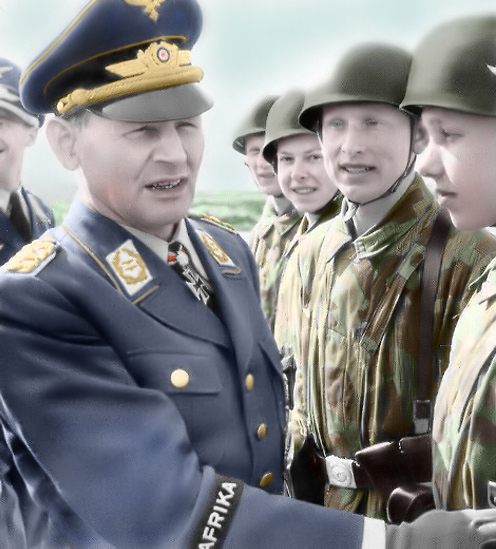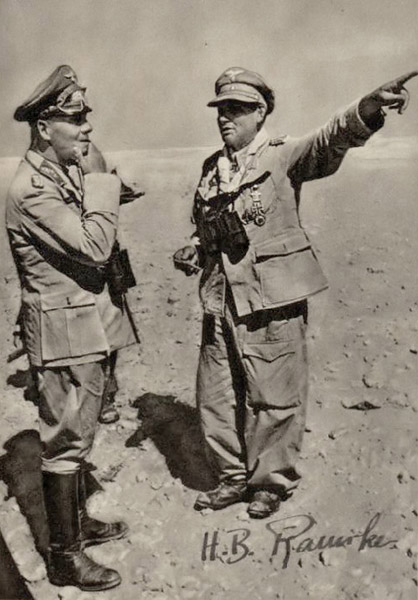General der Fallschirmtruppe Bernhard-Hermann Ramcke
24th January 1889 - 4th July 1968


Bernhard-Hermann Ramcke was born on January 24th 1889 into a family of farmers. He decided not to follow in the family trade but instead joined the Navy. Ramcke fought on the Western Front in WW1 as a Marine Infantryman. He took part in the fighting at Flanders and was awarded both Iron Crosses. In 1918 he was awarded the Imperial Prussian Service Cross and promoted to Leutnant. He ended WW1 as an Oberleutnant and remained in the post war 100 000 man army of the Reichswehr.
He was promoted to Hauptmann on February 1st 1927, Major on September 1st 1934 and Oberstleutnant on March 16th 1937. On July 19th 1940, Ramcke was transferred to the 7th Flieger Division and on July 31st joined the Fallschirmtruppe and was awarded the parachute qualification badge at the age of 51.
He first served in a parachute replacement Battalion and tried everything in his power to procure heavy weapons for the 7th Flieger Division. It was only after promotion to Oberst and command of the battalion did he manage to obtain his request.
Ramcke took part in the planning of troop employment in the forthcoming operation to invade Crete. He did not fly into Crete on May 20th but was chosen by General Student to drop into Maleme on the 21st. The commander of the Sturm Regiment, Oberst Meindl had been seriously wounded on the first day of the invasion and Group West lacked a capable commander to carry on with the momentum of the attacks at Maleme. Maleme had now become the primary objective of the invasion.
At 1800 on May 21st, Ramcke and 500 Fallschirmjäger reinforcements dropped into Crete west of the Tavronitis and east of the airfield at Maleme. Upon landing, Ramcke was briefed on the current situation by Oberleutnant Göttsche, the Nachrichtenoffizier of Luftlande Sturmregiment Stab. (I personally know a veteran who was present when Ramcke landed near Maleme. He was messenger for St.Rgt.Stab.Kompanie and was dispatched westward to inform Hauptmann Gericke of Ramcke's arrival. This short journey through bandit country was a tough experience and one that he does not like to talk about)
Oberst Meindl had been evacuated; many of the Sturm Regiment officers had been killed or wounded in the fighting. However, there was some good news. Maleme airfield had been captured but enemy artillery spotters were dug in on the slopes of Hill 107, which overlooked the airfield and were directing fire on to the airstrip. One assault group was about to launch an attack on Hill 107 and the first of the JU52's carrying the badly needed Mountain Troops had just landed, although under heavy artillery fire. Once grouped, the Gebirgsjäger were ordered to head south and outflank the enemy positions. Two battle groups of Fallschirmjäger were ordered eastwards to try and break through to Group Centre at Chania.
In the evening of the 21st, Ramcke was informed that the assault on Hill 107 had failed. Hours later he was informed that the seaborne armada had been destroyed whilst en-route to Crete.
Overnight on 21st/22nd, the NZ defenders on Hill 107 withdrew from their positions fearing they would be outflanked. The empty positions were found early morning on May 22nd. More and more JU52's began to land on the airfield at Maleme, no longer under artillery fire. The Gebirgsjäger commander, General Ringel, landed on the 22nd and Ramcke handed over command of German forces in the west of the island. He then joined his battlegroups who had broken out to the east and took part in the fierce fighting for the Platanias Ridge, which overlooked the northern coast toward Chania.
During the night of 24th/25th. Ramcke's forces broke through to Oberst Heidrich at Galatos. The New Zealand defence line was smashed by Stuka dive bombers and the way to Chania was open. The town fell on May 27th.
Ramcke was appalled at the atrocities carried out by the Cretan population and ordered many reprisals. Villages where mutilated bodies of Fallschirmjäger were discovered were raised to the ground.
Operation Mercury ended on June 2nd and on the 18th Ramcke returned to his replacement battalion to teach the men valuable lessons learnt on Crete.
On August 1st 1941, Ramcke was promoted to Generalmajor.
On August 21st, Ramcke was ordered to Görings HQ at Goldap in East Prussia and presented with the Knights Cross.
In early 1942, Ramcke served briefly with the Italian Army before being recalled to Berlin with new orders.
Rommel had asked Berlin for reinforcements to be sent to North Afrika. Early in the summer of 1942, General Student received orders to form a Fallschirm-Brigade to be sent to Afrika. Ramcke was given command of 4 Jäger Battalions, an Artillery Battalion and a Signals & Pioneer Platoon and an Anti-Tank Kompanie, to be known as Fallschirm-Brigade Ramcke.
They arrived in Afrika in July 1942 and were to be used to exploit any gap in the El Alamein line and break through to the Suez Canal, the British lifeline to the far-east.
Montgomery launched a counteroffensive in October 1942, which successfully broke the Axis line. The Ramcke Brigade were threatened with being cut off and surrounded. Due to the lack of transport, Ramcke's men had to march back toward the German lines but the line had moved due to increasing British pressure. As far as the German command was aware, the Ramcke Brigade was missing in action.
Whilst marching across the desert Ramcke's men intercepted and captured a British 8th Army supply column and the trucks were used to drive through the British lines and back to the safety of German held territory.
Ramkce was then posted back to Germany and was given command of FJD2. On November 13th 1942, he was informed that he was the 145th recipient of the Oakleaves to the Knights Cross.
FJD2 was being raised in Brittany, France from remnants of his Afrikan Brigade and veterans of the eastern front. It was subordinated to the German 7th Army until May 1943 when it went to Southern France, subordinated to General Student's XI Flieger Korps.
When the Allies invaded Sicily in July 1943, FJD2 was put on standby south of Rome. When the Italian Army capitulated in September 1943 it was FJD2 who restored order in Rome. Units from the Division carried out 4 air assaults whilst in Italy.
On September 9th, II/FJR6, parachuted onto Monte Rotondo north east of Rome to capture the Italian general staff. On September 12th, I/FJR7 landed in gliders on the Gran Sasso to rescue Mussolini. On September 17th, III/FJR7, parachuted onto the island of Elba to capture the Italian garrison stationed there.
After order had been restored, FJD2 assumed coastal defence duties until early November 1943 when it was mobilized for Russia. The division arrived in Russia between November 17th-27th minus 3 battalions, (On November 12th, I/FJR2 parachuted onto Leros. 2 other battalions were still committed in Italy).
The division took up position near the Russian held town of Zhitomir and whilst in Russia the division suffered heavy casualties. Ramcke left the division on two occasions and rejoined them again in March 1944. He returned to Berlin before the division was withdrawn from Russia to Cologne in May of that year when he resumed command.
The losses to FJD had been appalling; it would be the last time that Ramckes division would fight in Russia.
On June 13th, FJD2 was ordered to move to Brittany to defend against further allied airborne assaults. The divisions FJR6 had been operation in Normandy since May 1944 and had taken heavy casualties in the Cotentin Peninsula.
The division suffered heavily in its transit to Brittany. Allied aircraft ruled the skies above Normandy and Brittany and the French Resistance movement was attacking any German units they could find.
On August 3rd, elements of FJD2 were attacked at Avranches.
On August 5th, the divisional recon battalion was almost destroyed near Gouarec. FJR7 saw fierce fighting at Hulegoat and suffered heavy casualties.
On August 8th, US forces approached the town of Brest and demanded their surrender. When FJD2 arrived, Ramcke took command of Brest as senior officer and when the fighting continued Ramcke found his forces were facing 3 US armoured divisions and constant attacks by resistance units.
Ramcke successfully managed to evacuate 40 000 civilians from the Brest area before new American assaults began on August 20th.
On September 1st, Festung Brest was completely surrounded. The gauge of the fighting at Brest can be measured by the amount of Knights Crosses that were awarded. 7 Knights Crosses were awarded with many recommendations. 6 of these were to men of FJR7.
On September 13th, Ramcke was again asked to surrender by US General Middleton. Ramcke refused and the fighting continued until September 19th, when American forces reached Ramcke's command bunker. General der Fallschirmtruppe Bernhard Hermann Ramcke surrendered Fortress Brest and resistance ceased in the evening of the 19th, the same day he was awarded the Swords (99th Recipient) & Diamonds (20th recipient) to the Knights Cross.
Ramcke was shipped to the USA as a POW and later to England and France. In France he managed to escape from captivity but soon gave himself up. He was given an additional 5 years sentence, which was subsequently dropped.

German officers at Trent Park - England
back row from left to right: General der Infantrie Dietrich von Choltitz, Oberst Gerhard Wilck, General der Fallschirmtruppe Hermann-Bernhard Ramcke, Generalmajor Kurt Eberding, Oberst Eberhard Wildermuth
front row from left to right: Generalleutnant Rüdiger von Heyking, Generalleutnant Karl-Wilhelm von Schlieben, Generalleutnant Wilhelm Daser
Ramcke's only wish whilst in captivity was that his men were fairly treated. He had always been affectionately called "Papa" by his men. On his release, Ramcke returned to Germany and died on July 4th 1968 at Kappeln in Northern Germany.
![]()

Greeting the men of the Fallschirm-Brigade Ramcke

Ramcke and Rommel discuss forthcoming events

Ramcke seen here with Kurt Student
